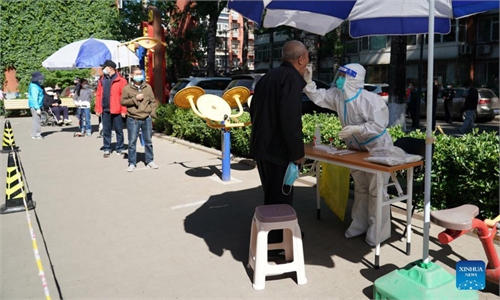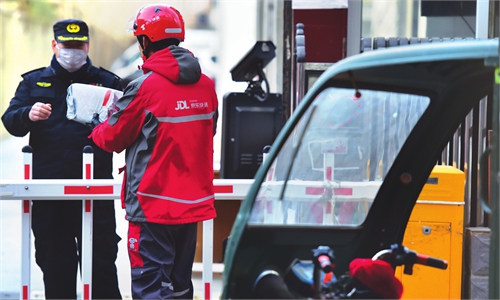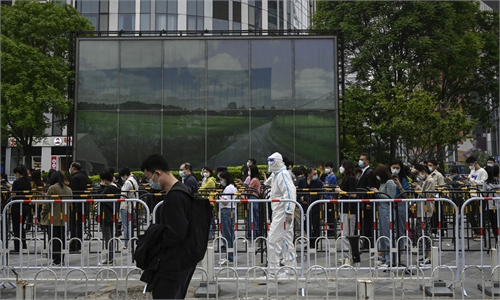Beijing reports four clusters of infections, continues mass testing in 12 areas
Deliverymen, bus drivers and sanitation workers are key groups
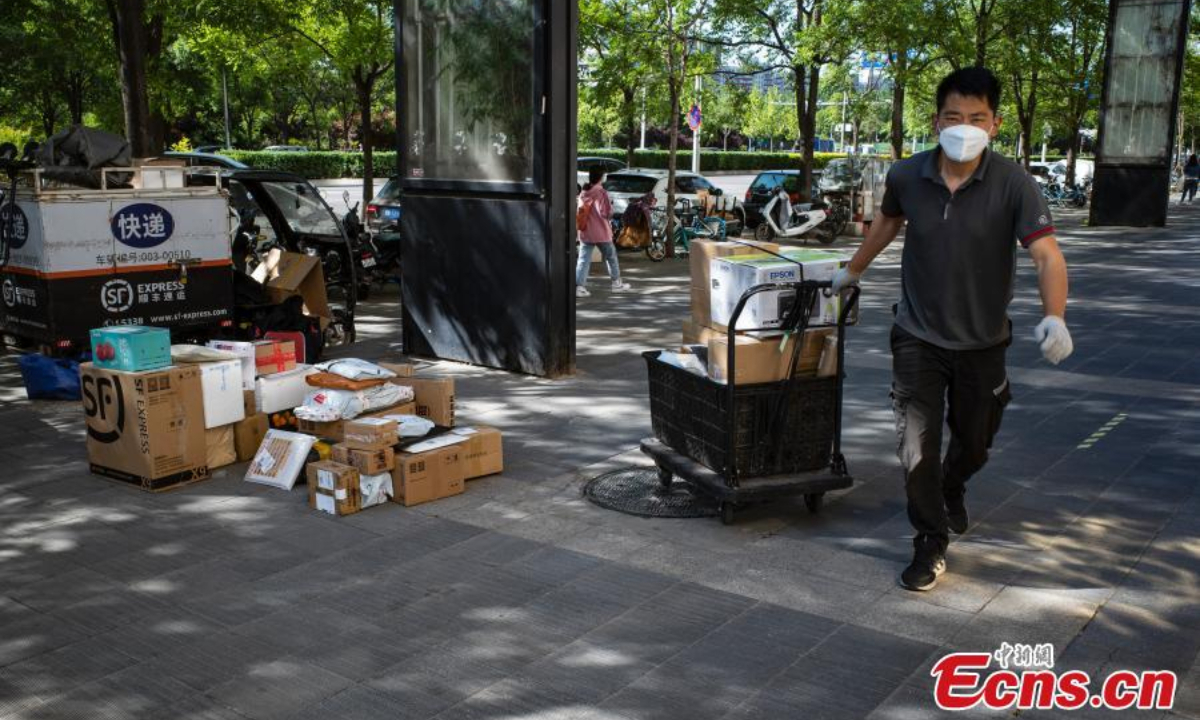
A man delivers packages to a community in Chaoyang District, Beijing, May 13, 2022. Photo:China News Service
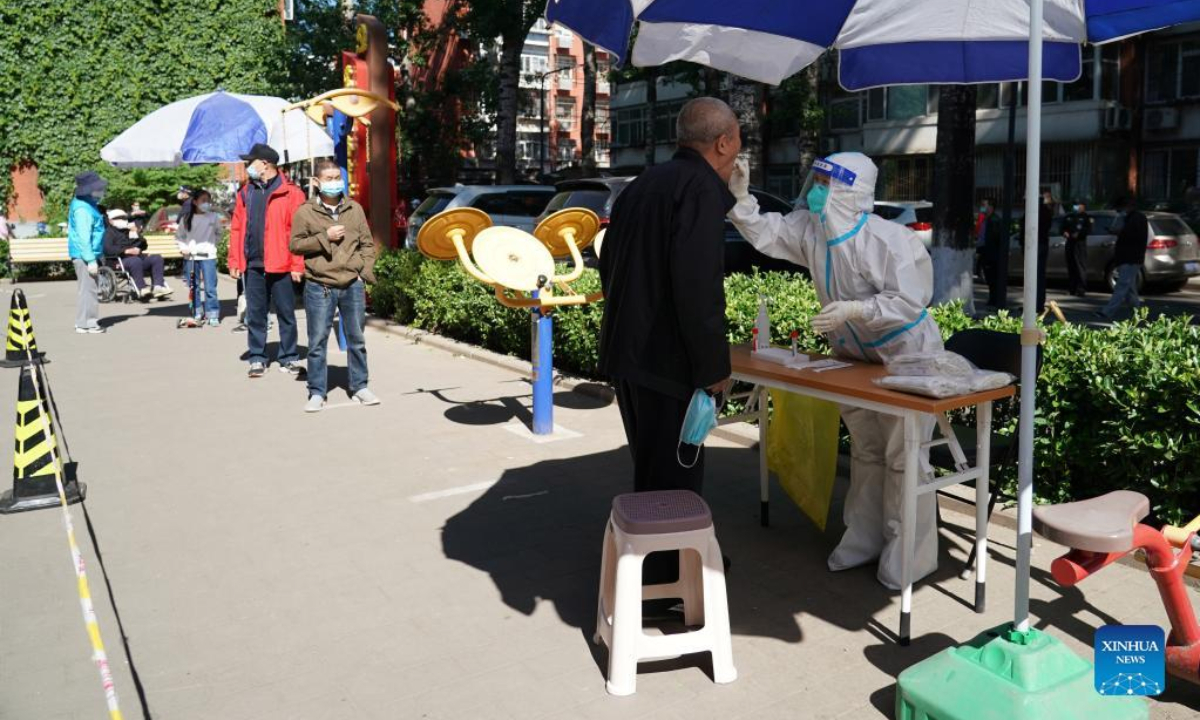
A medic takes a swab sample from a resident for nucleic acid test at a community in Haidian District of Beijing, capital of China, May 13, 2022. Beijing has started three additional rounds of mass nucleic acid testing in 12 districts from Friday to Sunday, as the Chinese capital races against time to contain the latest resurgence of COVID-19 infections. Photo:Xinhua
Beijing suspended more businesses and announced another three rounds of mass nucleic acid testing in 12 areas on Monday, as local health authorities said the city's daily growth of new cases remained high and the sneaky sources of infections and transmission in communities still have not been cut off."The source of infections in Beijing is very sneaky and community-level transmission hasn't yet been cut off," Pang Xinghuo with the Beijing Municipal Disease Prevention and Control Center said at Sunday's press conference.
The daily tally of new cases reported on Sunday by the Beijing Municipal Health Commission was 55, of which 45 were detected in quarantined and controlled regions and 10 others in communities.
According to Pang, a fresh clustered outbreak occurred in Fengtai district's Yuegezhuang market, with 15 positive results. Ten of them were people working at the market and the other five were their family members.
Meanwhile, a clustered outbreak relating to Yunda Express, a courier services company in Fangshan district, continued to extend with a total of 21 infections reported. Positive infections related to the clustered outbreak of China Railway increased to 68 and another clustered outbreak was linked to bus drivers.
Early on Sunday, the Beijing Municipal Health Commission urged the city to strengthen nucleic acid testing on key groups working in public services such as deliverymen, tradesmen and waiters, bus and subway drivers and sanitation workers.
A total of 21.19 million people in 12 areas of Beijing took tests on Saturday, with 11 tubes of samples positive - eight were from Fengtai district and three from Haidian district.
As a result, Fengtai suspended operations of indoor recreational venues, gyms and training institutes on Sunday.
About the fact that Beijing's double-digit growth of daily new cases came after rounds of mass nucleic acid testing, experts said it proved that Beijing's current anti-epidemic methods are effective. But sneaky viral transmissions and sporadic cases in communities show it's not yet time to let down the city's guard against Omicron.
More rounds of mass testing would screen out potential cases in communities and cut off the viral spread as early as possible. By sticking to the current method, which is a combination of Shanghai's and Shenzhen's experiences, Beijing will get over the surge soon, experts said.
To contain the latest COVID-19 flare-up, starting from Monday, residents in 12 areas in Beijing will be required to take another round of three-day mass nucleic acid tests. Residents living in four districts - Chaoyang, Fangshan, Shunyi and Fengtai - are still advised to work at home.
Wang Guangfa, a Beijing-based respiratory expert, told the Global Times on Sunday that Beijing's double-digit growth of cases is a good sign, as it proves the capital's fight against Omicron is on the right track. For the highly contagious Omicron, the number could have been in the thousands without effective measures.
Explaining why new cases are still being found in communities after rounds of tests, Wang said most cases in Beijing are linked to clustered outbreaks, which makes Omicron quickly spread among people in communities.
More rounds of testing would track how the virus spreads in communities, which offers indicators for health authorities to further shrink the scope of testing and even guide them in how to gradually relax anti-epidemic measures, Wang noted.
Beijing's epidemic is still severe but it has been coped with well and people shouldn't be overly worried about it as the city has accumulated rich experience from the Shanghai and Shenzhen outbreaks, Lu Hongzhou, head of Shenzhen's anti-epidemic expert team and head of the Third People's Hospital of Shenzhen, told the Global Times on Sunday.
Since April 22, a total of 461 samples of gene sequences showed Beijing registered two separate COVID-19 transmission chains and the two chains had created more branches of transmission chains. Gene sequencing of those cases showed they are same as those found in outbreaks and spillovers in other cities of the country, Pang said.
Experts also noted that those clustered outbreaks reported on Sunday indicate Beijing should remain on high alert in handling Omicron, suggesting more efforts in normal nucleic acid testing on key populations, in case of more emerging clustered infections.

